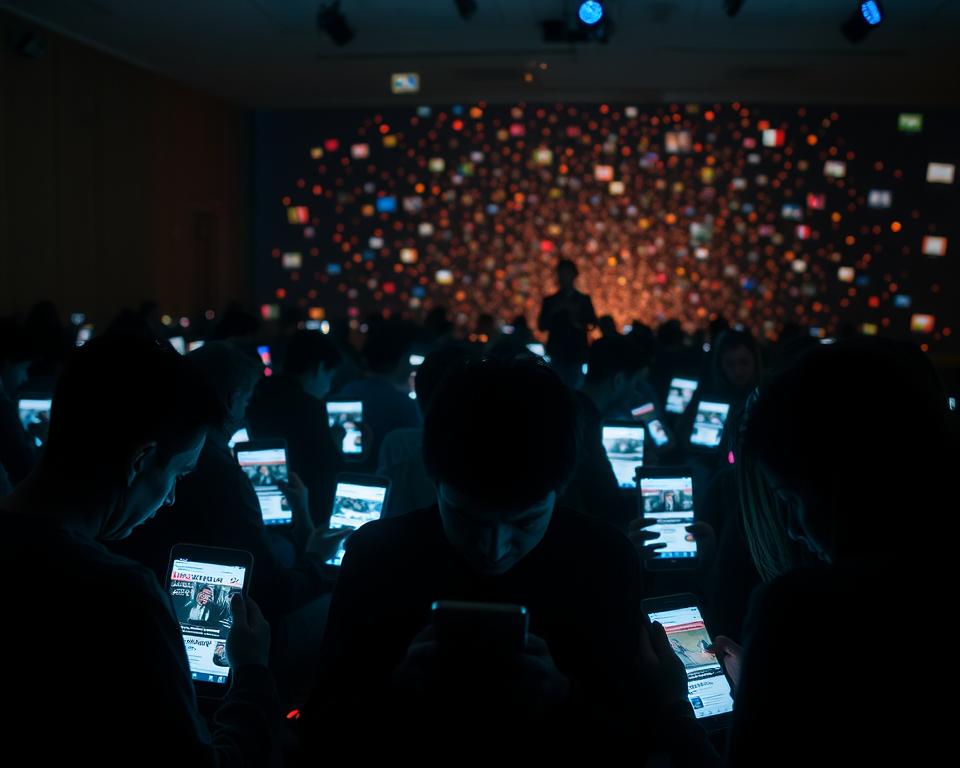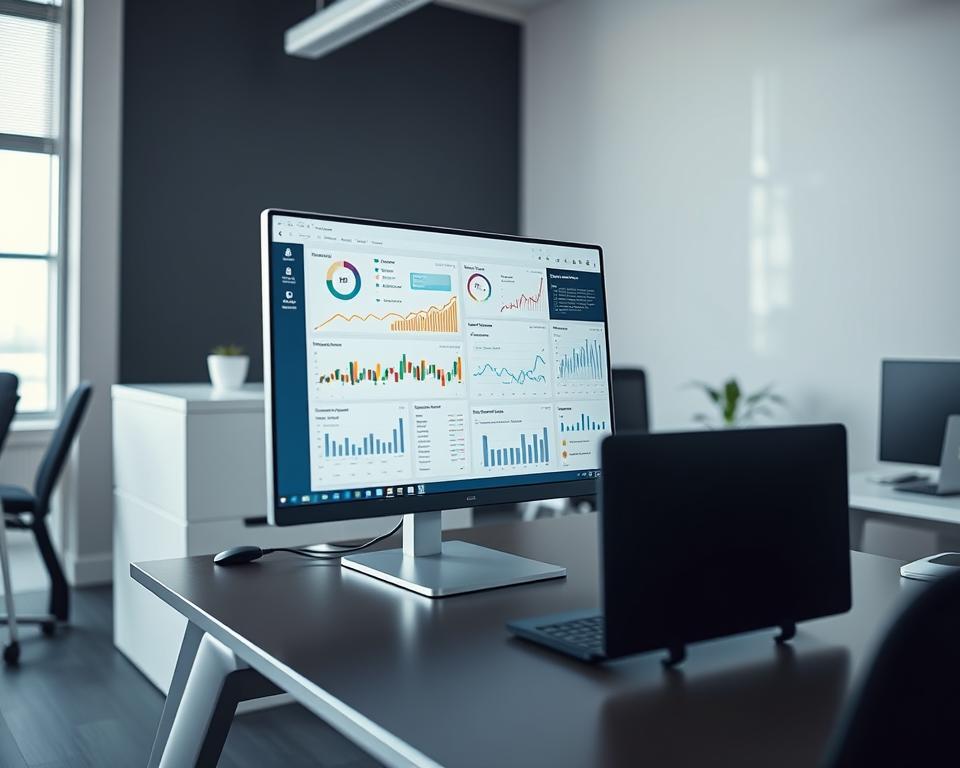Anúncios
social media psychology starts this Ultimate Guide by asking a simple question: could your always-on feeds be quietly reshaping your attention?
You live in a world where feeds, likes, and alerts compete for your time. This article explains how that constant stream shapes what you notice, remember, and feel. It draws on study findings and research to give you clear, practical steps.
This guide is friendly and educational. You’ll explore how platforms influence the information you see and the sense of connection you feel. You’ll also find simple habits to protect focus, improve sleep, and add support around your use without dramatic rules.
By the end, you’ll have plain-language insights, examples from real studies, and short experiments you can try this week to balance online connection with offline life.
What Social Media Is Today: Always-On Networks That Shape Attention
Today’s always-on networks shape how you notice and spend your time. In the U.S., platforms like Facebook, Instagram, TikTok, and X reach billions each day. Pew research shows about 69% of adults and 81% of teens use these services, so these networks set the pace for how people get news, plan events, and talk with friends.
Anúncios
Outcomes are mixed, and that’s normal. Some studies highlight real benefits: quick access to information, community, and support. Other research links heavy use to sleep disruption, mood changes, and broken focus.
- Always-on design invites attention at any hour; setting check times helps reduce interruption.
- Platforms share patterns—infinite feeds, alerts, and feedback—that pull users back repeatedly.
- Across ages, fit your media use to goals: adults may manage news intake; adolescents often need guidance around identity and peers.
Practical framing: expect trade-offs. More connection can improve belonging but also increase interruptions. This article will show simple habits and limits that keep the benefits while protecting focus, sleep, and your daily routine.
Inside the Reward Loop: How Likes and Notifications Capture Your Focus
Little rewards from apps quietly train where you aim your attention each day. Positive feedback lights up brain hubs like the striatum and the ventral tegmental area (VTA), which makes checking feel worthwhile.
Dopamine, unpredictability, and a slot-machine rhythm
“Unpredictable outcomes strengthen repeat behavior, much like a slot machine.” — Jacqueline Sperling, PhD
MRI work shows that viewing posts with many likes boosts activity in reward and attention regions. This helps explain why users check more than they plan and why public feedback can feel urgent.
Real example: Instagram likes, for instance, activate reward circuitry and social-processing zones. That response nudges behavior and can eat up time when badges and alerts pile up.
- Batch checks and turn off nonessential alerts to reduce interruption.
- Move platforms off your home screen and remove badges so cues are weaker.
- Silence likes where possible, favor private messages, and set a timer after posting.
Practical tip: Track your experience for a week—note how often you check and how you feel. Small changes shift these behavior patterns without demanding you quit everything.
Neuroscience in Action: What Studies Reveal About Attention and Memory
Modern brain scans reveal how brief online cues pull your attention and affect what you remember. MRI work shows that viewing posts with many likes lights up reward areas such as the striatum and VTA. That response steers attention toward social cues and away from tasks.
Reward centers and limited attention
When reward regions engage, your focus narrows. Attention networks are finite. Every switch to check a feed uses up working memory. That makes it harder to hold facts or solve problems.
Exclusion, emotion, and adolescents
Studies find that online exclusion activates emotional and sensory brain areas. People report sharp distraction after being left out of chats or posts. Adolescents often show stronger reactions because their brains are still developing.
- Create blocks of time with no social tabs to protect deep work.
- Write key information down before opening feeds to keep it in view.
- If exclusion hits, pause and label the feeling, then pick one action (message a friend or walk).
- Remember: sleep, stress, and workload are also important factors for focus.
“Small routines that reduce quick switches help attention and memory.”
From Scroll to Strain: Links to Sleep, Stress, and Cognitive Load
What you do with screens before bed affects more than rest — it changes how your brain performs the next day. Research links nighttime feed-checking to delayed sleep onset and lower sleep quality. That shift often shows up as poorer attention and weaker memory the next morning.
Sleep disruption and next-day focus
Blue light and late mental stimulation both interfere with sleep hormones and the natural wind-down process. Cutting off feeds at least an hour before bed reduces stimulation and may help protect rest.
The brain-body connection: stress, headaches, and tremors
Reports tie heavy platform use to anxiety, headaches, nausea, and tremors. These symptoms remind you that your nervous system reacts to prolonged online intensity.
- Try a simple evening routine: breathe, stretch, drink water, then reassess whether to return to apps.
- Keep your phone out of the bedroom or use a basic alarm clock to break late-night checks.
- Schedule low-stim time for reading or gentle hobbies to lower cognitive load before sleep.
- Track when you feel wired and how long it takes to settle; that data helps you pick better times to use platforms.
“Small timing changes often ease cognitive load and improve next-day focus.”
Adolescents vs. Adults: Different Risks, Different Supports
Age shapes how persistent feeds affect your focus, mood, and relationships. Early teen use can increase sensitivity to rewards, exclusion, and appearance comparisons. That makes adolescents especially vulnerable to swings in mood and attention.
Why early teen use heightens vulnerability: Teens are still building self-regulation. Heavy use can amplify reactions to likes and exclusion and change daily behavior and mental health.
Girls, relational aggression, and filtered comparisons: Young women often face fast-moving exclusion or comments that make school conflict feel public. A McLean Hospital example describes a seventh grader who saw posts about a “new best friend” and felt deeply hurt.
“A seventh grader described exclusion that turned a private shift into a public wound.”
Adults’ pressures: Grown-ups report pressure to match filtered faces. Some people change outfits, spending, or seek cosmetic fixes to match edited images.
- Parents can co-create clear hours, model phone-free attention, and keep devices out of bedrooms for children and teens.
- Adults can follow creators who share realistic content and mute accounts that trigger comparison.
- Researchers advise guidance and skill-building—not total bans—to help users navigate feeds and friendships.
If scrolling leaves you feeling lonely, pause and send a direct message or make an offline plan to restore real connection.
Identity Online: Curation, Comparison, and Your Sense of Self
How you present yourself online can shape how you feel about who you are. Image-heavy platforms let you highlight wins, hide work-in-progress, and try new roles. That flexibility can help you explore interests and connect with friends.
But there are trade-offs. Some users build a polished “false self” that feels hard to maintain. Over time, this can lower self-esteem and make real relationships feel distant.
Multiple personas and the “false self” problem
You can try different versions of yourself online. That can be freeing. Yet if you craft posts mainly to impress, you may lose sight of what truly matters to you.
When image-based platforms help—and when they harm
- Positive: sharing achievements can ease loneliness and strengthen relationships.
- Risk: filters and edits hide effort, which drives harmful comparison.
- Practical: limit editing (two quick adjustments), choose private circles for close sharing, and follow creators who show process, not only finished results.
- Self-check: notice body signals after posting; tension is a cue to step back and do something grounding.
“Use online spaces as one part of your life, not the whole story.”
Groups, Belonging, and Echoes: How Communities Help and Hinder Focus
Belonging to a group can sharpen your drive and make even boring tasks feel doable. Small check-ins from friends or strangers who share a goal boost motivation. Online communities often provide the support that helps you start and finish projects.
At their best, groups offer accountability and practical tips. Users trade progress updates, celebrate small wins, and keep each other on track. Some studies show that belonging raises the chance you’ll follow through on plans.
But tight feeds can narrow what you see. Over time, mimicry and identity bubbles form. People copy norms without noticing, and that can reshape your behavior and choices.
“Belonging helps start habits; echo chambers can shrink perspective.”
- Rotate the groups you visit so one circle doesn’t set every standard.
- Diversify who you follow with a few thoughtful voices outside your bubble.
- Use direct messages for real support and save public browsing for set times.
- Keep a visible goal—on your desk or pinned—to resist group-driven drift.
If a group raises anxiety or pushes likes over learning, mute it for a week and note how your focus and mood change.
News Feeds, Doomscrolling, and Attention Fragmentation
Feeds that refresh every minute turn curiosity into a habit you hardly notice. Rapid updates from social media platforms and news feeds nudge you to check again and again. Over time this fragments your attention and steals small chunks of productive time.

Why it happens: headlines and uncertain updates create a pull. When information feels urgent, you refresh to reduce doubt. That loop can raise anxiety and disrupt sleep, as some studies link heavy platform use to worse rest and mood.
- Set two or three short windows for news each day and avoid checking during focused work or before bed.
- Keep a short list of trusted sources instead of relying on algorithmic feeds; use a “top stories” page or an email digest to reduce hopping among platforms.
- If you feel pulled to refresh, write the one question you want answered. Once you find reliable information, close the app.
- For breaking events, accept that details change; wait for confirmed updates instead of reacting to every rumor.
- Move news apps to a secondary screen and remove badges; share one verified update with a friend if processing helps, then log off to protect your time.
Quick tip: if an example story keeps replaying in your mind, talk it out or journal. That often ends repetitive scrolling and helps you reclaim attention for the rest of your day.
social media psychology: What the Research Says About Focus and Mental Health
Controlled trials point to modest, actionable ways to protect focus and mood.
Overall research shows mixed outcomes: platforms can offer real connection, support, and fast access to information, yet heavy use can relate to anxiety, poor sleep, and lower focus.
A landmark randomized study at the University of Pennsylvania (2018) tested 143 undergraduates. Participants limited Facebook, Instagram, and Snapchat to 10 minutes per app per day for three weeks.
The limited group reported significant drops in loneliness and depression compared with the control group. That study suggests small, clear limits can shift mood without asking you to quit entirely.
- Benefits: quick support, news and friends’ updates, and brief mood boosts from feedback.
- Risks: more use can worsen sleep and attention for some users.
- Practical step: use built-in screen-time tools to measure media use and test short limits for a few weeks.
“Small, realistic limits often change how people feel—research shows trends, not guarantees.”
Time, Place, and Play: Building a Balanced Daily Rhythm
Small anchors—sleep, meals, and movement—help you fit online habits into a day that supports focus and rest. Plan clear blocks for work, breaks, and creative play so checking apps becomes a choice, not a reflex.
Anchor habits: sleep, movement, offline hobbies
Start with sleep hygiene: set a last-call time for online use and a morning start after you move and get light. Keep phones off the table at meals and across the room while you work.
Digital play with guardrails: creative posting, not constant checking
Use one short posting window and then step away. Try creative tasks that do not rely on feeds—drawing, music, short videos you finish before posting. That preserves joy without constant feedback loops.
- Fit social media into small windows between anchors.
- Schedule a weekly offline hobby hour with a friend for support.
- Bookmark community access on a computer for planned check-ins.
- Treat weekends as longer creative sessions with fewer alerts.
- Review your rhythm each Sunday and tweak as needed.
“Small, regular changes build a day that protects focus, sleep, and joy.”
Micro-Behaviors That Protect Your Attention
Micro-behaviors act like speed bumps that slow reflexive checking and protect your work. Try a few small changes and watch how your focus shifts. These steps are easy to try and simple to track.
Turn off nonessential alerts and badges
Turn off badges and most push alerts so your phone stops pulling you into content every few minutes. Hide like counts and mute keywords that spike anxiety.
Move apps off the home screen
Put social media apps in folders or on a secondary screen. Out of sight adds small friction and cuts reflex checks.
Use timers and grayscale during work blocks
Set a 25–50 minute timer for focused blocks and switch your phone to grayscale. Keep one or two high-value sources on your main screen only.
- Create a “support stack” near your desk: water, notepad, and a fidget to replace idle checking.
- Rate your anxiety and focus 0–10 before and after sessions for a week to spot patterns.
- Tell coworkers or friends when you’re in focus time so incoming messages drop.
- Unfollow accounts that push over-editing and favor creators who share process, not just finished work.
- Review screen-time reports weekly so your media use matches your goals and health needs.
“Small experiments reveal which micro-behaviors actually help you keep attention.”
Self-Experiments: Track Your Mood, Focus, and Use
Try a short, structured test this week to see how your daily social media use affects mood and focus. The goal is simple: gather real information so you can spot patterns and try one change.
- For seven days, pick two daily windows to check feeds and rate mood, anxiety, and focus 0–10 before and after each session.
- Note minutes, what content you saw or posted, where you were, and who you were with to capture context.
- At week’s end, look for patterns: times that raise anxiety, content that drains energy, and situations that help focus.
Try one change next week: shorten a window, switch content, or move to a different place to scroll. Repeat the same ratings and compare the information side by side.
- Use an example sheet: Day/Time, Minutes, Content Type, Before/After Ratings, Notes.
- If loneliness rises, swap one public session for a direct message or a short call.
- If certain topics trigger stress, mute that content and follow accounts that teach skills you want to practice.
“Rate feelings the same way each day to spot real change.” — Sperling recommendation
One final note: this experiment is educational, not diagnostic. If mental health concerns persist or worsen, talk with a licensed professional for tailored guidance.
Parents and Caregivers: Modeling, Boundaries, and Support
Parents shape online habits more by example than by rules. Create clear, simple routines that protect family focus while teaching safe use. Keep conversations calm and practical—no shaming, no grand promises.
Family media plans and nighttime check-ins
Make a short family media plan with quiet hours and a charging spot outside bedrooms. Ask kids to turn in devices at night and hold a weekly check-in to talk about posts and privacy.
“No selfie” or object-first sharing for younger users
Try a “no selfie” rule or ask children to share an object or a moment first. This shifts focus from appearance to experiences and learning.
Modeling attention: put your phone down first
Put your own phone away during meals and conversations. People notice what you do more than what you say. Showing attention teaches your children how to value time and relationships.
- Create a simple plan: shared quiet hours, charging spots, weekly check-ins.
- Review posts together to teach privacy and permanence, not to punish.
- Offer safe alternatives for late chats so kids feel included without constant alerts.
“When adults model calm attention, kids copy that behavior more reliably than any rule.”
Design and Policy: Platform Choices That Could Ease the Pressure
Design choices at the platform level can lower pressure without taking away connection. Thoughtful defaults and clear settings give you tools to protect focus while keeping the benefits of social media.
Likes limits, private-by-default, and one-to-one emphasis
Platforms can reduce public scoring by hiding like counts, limiting visible popularity metrics, and making new accounts private by default. Small-group messaging and one-to-one threads emphasize real connection over public performance.
- Hide public like counts to ease instant gratification.
- Set new accounts to private so individuals control who sees content.
- Promote small-group features that support genuine support and conversation.
Trade-offs: connection vs. mass sharing
Mass sharing spreads ideas fast. But it also raises comparison pressure and distracts you more often.
- Mass reach helps causes and discovery but can amplify stress.
- Smaller circles reduce distraction but limit rapid information spread.
- Research and pilot studies can test which defaults help focus without cutting useful features.
“Limit likes, reduce mass sharing, and emphasize one-to-one communication.” — Sperling recommendation
You can try privacy-first settings and turn off like counts now. Clearer information about feed ranking and scheduled alerts would help individuals pick the ways they engage to match goals and health.
Work and School: Keeping Focus in High-Distraction Environments
When classrooms and offices brim with devices, staying focused becomes a deliberate practice.
Small rules and clear windows help you protect attention without dramatic change. Try concrete tactics that suit your role and test one tweak per week.
Academic examples: study blocks, device distance, and app limits
In a study session, place your phone across the room and use website blockers during timed blocks. This adds simple friction and reduces reflex checking.
- Template: 45 minutes focused, 10 minutes off; limit social media checks to the break.
- Keep only necessary tabs open and store references in one document so information is easy to find.
- Track a quick focus score (1–10) after each block to see what schedule helps your work.
Professional examples: notification windows and meeting norms
At work, set two daily notification windows and turn off alerts the rest of the day. Batch checks prevent constant context switching.
- Share meeting norms that limit laptops or phones unless needed; this helps adults stay present and keep meetings short.
- Use status messages to signal deep work and reduce interruptions from colleagues.
- If monitoring feeds is part of your role, rotate coverage and use dashboards instead of open streams.
“Individuals differ; test one change per week and keep what helps your output and well‑being.”
Conclusion
Conclusion
A few steady practices can keep online tools useful without letting them run your day.
You’ve seen how social media psychology links reward loops, fast news, and group dynamics to attention. Try two simple ways this week: batch checks and turn off badges. Notice how your experience and focus change.
Balance your day with anchors—sleep, movement, and play—so media fits into life rather than running it. Favor direct messages and real-world plans to keep genuine connection strong.
If stress, anxiety, or sleep problems persist, seek qualified professional support. Share what works with others and evolve your plan as your life and the world change.



